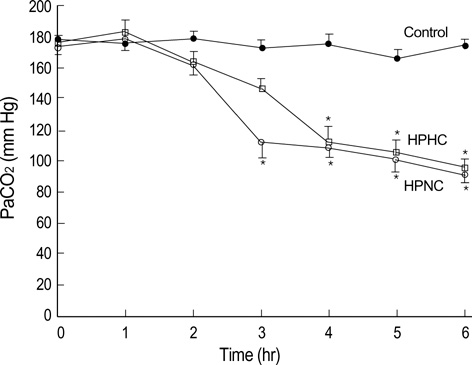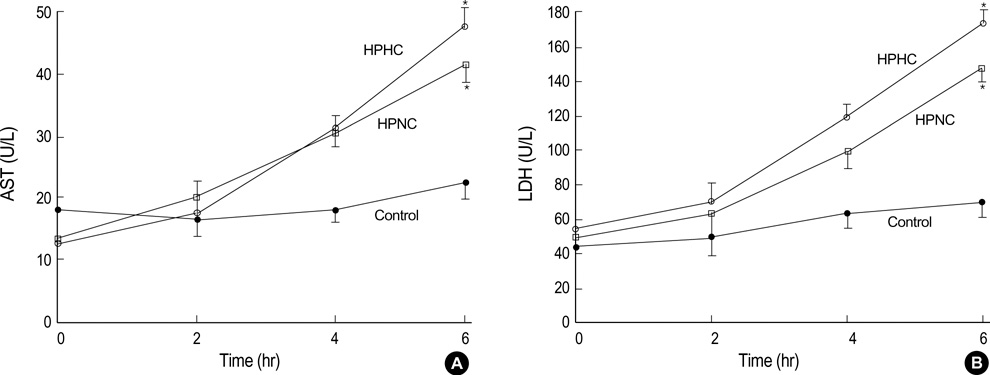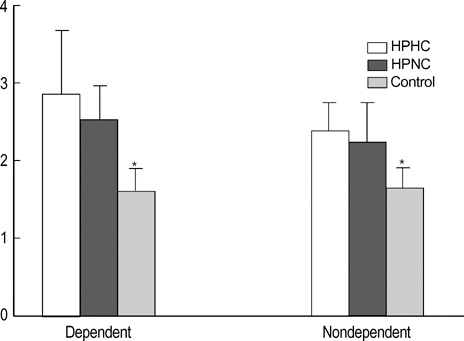J Korean Med Sci.
2005 Oct;20(5):764-769. 10.3346/jkms.2005.20.5.764.
Does Hypercapnic Acidosis, induced by Adding CO2 to Inspired Gas, Have Protective Effect in a Ventilator-induced Lung Injury?
- Affiliations
-
- 1Department of Internal Medicine, Chonnam National University Hospital, Gwangju, Korea. lscmd@chonnam.ac.kr
- KMID: 1781758
- DOI: http://doi.org/10.3346/jkms.2005.20.5.764
Abstract
- To investigate whether hypercapnic acidosis, induced by adding CO2 to inspired gas, would be protective effect against ventilator-induced lung injury (VILI), we ventilated 55 normal white rabbits for 6 hr or until PaO2/FIO2 <200 mmHg. Control group (n=15) was ventilated with peak inspiratory pressure (PIP) of 15 cm H2O, positive end-expiratory pressure (PEEP) of 3 cm H2O, an inspiration-to-expiration ratio of 1:2, and an inspired oxygen fraction (FIO2) of 0.40. High pressure hypercapnic group (HPHC; n=20) was ventilated with PIP of 30 cm H2O, PEEP of 0 cm H2O, and FIO2 of 0.40. Carbon dioxide was introduced into the inspiratory limb of the ventilator circuit, as necessary to maintain hypercapnia (PaCO2, 65 to 75 mmHg). High pressure normocapnic group (HPNC; n=20) was ventilated with same setting of HPHC, except normocapnia (PaCO2, 35 to 45 mmHg). Bronchoalveolar lavage fluid (BALF) lactate dehydrogenase, aspartate aminotransferase, interleukin-8 were significantly higher in high pressure ventilator group than control group (p<0.05). Wet weight to dry weight (WW/DW) and histologic scores were significantly higher in high pressure ventilator group than control group (p<0.05). However, there were no significant differences in oxygenation, BALF inflammatory markers, WW/DW and histologic scores between HPHC and HPNC groups. These findings suggest that hypercapnic acidosis at least induced by CO2 insufflation would not be protective effect against VILI in this model.
MeSH Terms
-
Acidosis, Respiratory/*chemically induced/complications/diagnosis/physiopathology
Administration, Inhalation
Animals
Carbon Dioxide/*administration and dosage
Hypercapnia/*chemically induced/complications/diagnosis/physiopathology
Inhalation
Pulmonary Gas Exchange
Rabbits
Research Support, Non-U.S. Gov't
Respiration, Artificial/*adverse effects
Respiratory Distress Syndrome, Adult/diagnosis/*etiology/physiopathology/*prevention and control
Treatment Outcome
Figure
Reference
-
1. Amato MB, Barbas CS, Medeiros DM, Magaldi RB, Schettino GP, Lorenzi-Fihlo G, Kairalla RA, Deheinzelin D, Munoz C, Oliveira R, Takagaki TY, Carvalho CR. Effect of a protective-ventilation strategy on mortality in the acute respiratory distress syndrome. N Engl J Med. 1998. 338:347–354.
Article2. Brochard L, Roudot-Thoraval F, Roupie E, Delclaux C, Chastre J, Fernandez-Mondejar E, Clementi E, Mancebo J, Factor P, Matamis D, Ranieri M, Blanch L, Rodi G, Mentec H, Dreyfuss D, Ferrer M, Brun-Buisson C, Tobin M, Lemaire F. The Multicenter Trial Group on Tidal Volume reduction in ARDS. Tidal volume reduction for prevention of ventilator-induced lung injury in acute respiratory distress syndrome. Am J Respir Crit Care Med. 1998. 158:1831–1838.3. Hickling KG, Walsh J, Henderson S, Jackson R. Low mortality rate in adult respiratory distress syndrome using low-volume, pressure-limited ventilation with permissive hypercapnia: a prospective study. Crit Care Med. 1994. 22:1568–1578.
Article4. Shibata K, Cregg N, Engelberts D, Takeuchi A, Fedorko L, Kavanagh BP. Hypercapnic acidosis may attenuate acute lung injury by inhibition of endogenous xanthine oxidase. Am J Respir Crit Care Med. 1998. 158:1578–1584.
Article5. Laffey JG, Engelberts D, Kavanagh BP. Buffering hypercapnic acidosis worsens acute lung injury. Am J Respir Crit Care Med. 2000. 161:141–146.
Article6. Laffey JG, Tanaka M, Engelberts D, Luo X, Yiang S, Tanswell TK, Post M, Lindsay T, Kavanagh BP. Therapeutic hypercapnia reduces pulmonary and systemic injury following in vivo lung reperfusion. Am J Respir Crit Care Med. 2000. 162:2287–2294.7. Laffey JG, Jankov R, Engelberts D, Tanswell AK, Post M, Lindsay T, Mullen JB, Romaschin A, Stephens D, McKerlie C, Kavanagh BP. Effects of therapeutic hypercapnia on mesenteric ischemia-reperfusion injury. Am J Respir Crit Care Med. 2003. 168:1383–1390.
Article8. Laffey JG, Honan D, Hopkins N, Hyvelin JM, Boylan JF, McLoughlin P. Hypercapnic acidosis attenuates endotoxin-induced acute lung injury. Am J Respir Crit Care Med. 2004. 169:46–56.
Article9. Broccard AF, Hotchkiss JR, Vannay C, Markert M, Sauty A, Feihl F, Schaller M. Protective effects of hypercapnic acidosis on ventilator-induced lung injury. Am J Respir Crit Care Med. 2001. 164:802–806.
Article10. Sinclair SE, Kregenow DA, Lamm WJ, Starr IR, Chi EY, Hlastala MP. Hypercapnic acidosis is protective in an in vivo model of ventilator-induced lung injury. Am J Respir Crit Care Med. 2002. 166:403–408.11. Laffey JG, Engelberts D, Duggan M, Veldheuizen R, Lewis JF, Kavanagh BP. Carbon dioxide attenuates pulmonary impairment resulting from hyperventilation. Crit Care Med. 2003. 31:2634–2640.
Article12. Hickling KG. Lung protective ventilation in acute respiratory distress syndrome protection by reduced lung stress or by therapeutic hypercapnia? Am J Respir Crit Care Med. 2000. 162:2021–2022.13. Laffey JG, Kavanagh BP. Carbon dioxide and the critically ill: too little of a good thing? Lancet. 1999. 354:1283–1286.14. Rai S, Engelberts D, Laffey JG, Frevert C, Kajikawa O, Martin TR, Post M, Kavanagh BP. Therapeutic hypercapnia is not protective in the in vivo surfactant-depleted rabbit lung. Pediatr Res. 2004. 55:42–49.
Article15. Miller EJ, Cohen AB, Nagao S, Griffith D, Maunder RJ, Martin TR, Weiner-Kronish JP, Sticherling M, Christophers E, Matthay MA. Elevated levels of NAP-1/interleukin-8 are present in the airspaces of patients with the adult respiratory distress syndrome and are associated with increased mortality. Am Rev Respir Dis. 1992. 146:427–432.
Article16. Nakamura H, Ishizaka A, Sawafuji M, Urano T, Fujishima S, Sakamaki F, Sayama K, Kawamura M, Kato R, Kikuchi K, Kanazawa M, Kawashiro T. Elevated levels of interleukin-8 and leukotriene B4 in pulmonary edema fluid of a patient with reexpansion pulmonary edema. Am J Respir Crit Care Med. 1994. 149:1037–1040.17. Hickling KG, Joyce C. Permissive hypercapnia in ARDS and its effect on tissue oxygenation. Acta Anaesthesiol Scand Suppl. 1995. 107:201–208.
Article18. Xu L, Glassford AJ, Giaccia AJ, Giffard RG. Acidosis reduces neuronal apoptosis. Neuroreport. 1998. 30:875–879.
Article19. Ranieri VM, Suter PM, Tortorella C, De Tullio R, Dayer JM, Brienza A, Bruno F, Slutsky AS. Effect of mechanical ventilation on inflammatory mediators in patients with acute respiratory distress syndrome: a randomized controlled trial. JAMA. 1999. 282:54–61.
Article20. Behnia R, Molteni A, Waters CM, Panos RJ, Ward WF, Schnaper HW, Ts'ao CH. Early markers of ventilator-induced lung injury in rats. Ann Clin Lab Sci. 1996. 26:437–450.21. Swenson ER. Therapeutic hypercapnic acidosis. Am J Respir Crit Care Med. 2004. 169:8–9.
Article22. Laffey JG, O'Croinin D, McLoughlin P, Kavanagh BP. Permissive hypercapnia-role in protective lung ventilatory strategies. Intensive Care Med. 2004. 30:347–356.
- Full Text Links
- Actions
-
Cited
- CITED
-
- Close
- Share
- Similar articles
-
- Ventilator Induced Lung Injury (VILI) and Strategies to Minimize the Injury
- Ventilator-Induced Lung Injury
- A Case of Pumpless Interventional Lung Assist Application in a Tuberculosis Destroyed Lung Patient with Severe Hypercapnic Respiratory Failure
- Clinical Trial of Tracheal Gas Insufflation to Control Hypercapnia Occured during Laparoscopic Surgery: A Case Report
- Biotrauma in Ventilator Induced Lung Injury







